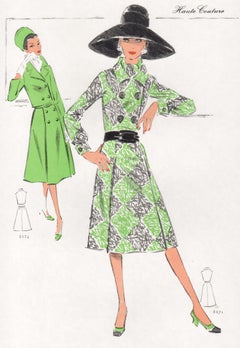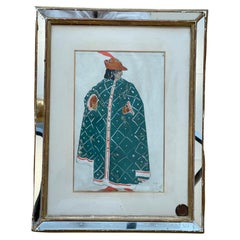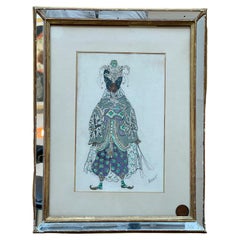Léon Bakst Art
to
1
1
1
1
1
1
Leon Bakst Three Costume designs from Le Dieu Bleu Ballet 1911
By Leon Bakst
Located in Paonia, CO
Three iconic Leon Bakst costume designs for Le Dieu Bleu ( The Blue God ) a ballet choreographed by Michel Fokine and written by Cocteau. The ballet premiered in Paris in 1...
Category
20th Century Art Nouveau Léon Bakst Art
Materials
Color
Portrait of Philip Andreevich Malavin.1879.Paper, lithography, 32x23 cm with def
By Leon Bakst
Located in Riga, LV
Portrait of Philip Andreevich Malavin.1879.Paper, lithography, 32x23 cm with minor defects.
Leon Bakst. (1866-1924)
Category
1870s Art Nouveau Léon Bakst Art
Materials
Lithograph, Paper
Related Items
Cadieux
By Henri de Toulouse-Lautrec
Located in East Quogue, NY
Limited edition vintage lithographic reproduction poster of "Cadieux" by Henri de Toulouse Lautrec, published in 1968 by The Sunday Times (London).
This limited edition poster is nu...
Category
1890s Art Nouveau Léon Bakst Art
Materials
Lithograph
French Mid-Century 1970s Fashion Design Vintage Lithograph Print
Located in Melbourne, Victoria
Original colour lithograph of a French fashion design from 'Haute Couture'. Published in a folio of designs for Summer 1971.
32cm by 22cm (sheet)
Category
1970s Post-War Léon Bakst Art
Materials
Lithograph
Jean Cocteau - Young Girl - Original Lithograph
By Jean Cocteau
Located in Collonge Bellerive, Geneve, CH
Jean Cocteau - Young Girl - Original Lithograph
Signed and dated in the plate
Stampsigned
Dimensions: 53 x 42 cm
1956
Provenance : Succession Dermit, Cocteau's heir
Category
1950s Modern Léon Bakst Art
Materials
Lithograph
LUXIOR Automobile early automotive original vintage poster
By Georges Henri Privat-Livemont
Located in Spokane, WA
LUXIOR. Original antique French turn of the century rare antique automobile poster. Printer / atelier:: Henri Privat Livemont. Size: 15.75" ...
Category
1910s Art Nouveau Léon Bakst Art
Materials
Lithograph
H 23.75 in W 15.75 in D 0.05 in
Le Théâtrophone
By Jules Chéret
Located in East Quogue, NY
Limited edition vintage lithographic reproduction poster of "Le Théâtrophone" by Jules Cheret, published in 1968 by The Sunday Times (London).
This limited edition poster is numbere...
Category
1890s Art Nouveau Léon Bakst Art
Materials
Lithograph
Marc Chagall - Original Lithograph
By Marc Chagall
Located in Collonge Bellerive, Geneve, CH
Marc Chagall
Original Lithograph
1963
Dimensions: 32 x 24 cm
Reference: Chagall Lithographe 1957-1962. VOLUME II.
Condition : Excellent
Marc Chagall (born in 1887)
Marc Chagall was born in Belarus in 1887 and developed an early interest in art. After studying painting, in 1907 he left Russia for Paris, where he lived in an artist colony on the city’s outskirts. Fusing his own personal, dreamlike imagery with hints of the fauvism and cubism popular in France at the time, Chagall created his most lasting work—including I and the Village (1911)—some of which would be featured in the Salon des Indépendants exhibitions. After returning to Vitebsk for a visit in 1914, the outbreak of WWI trapped Chagall in Russia. He returned to France in 1923 but was forced to flee the country and Nazi persecution during WWII. Finding asylum in the U.S., Chagall became involved in set and costume design before returning to France in 1948. In his later years, he experimented with new art forms and was commissioned to produce numerous large-scale works. Chagall died in St.-Paul-de-Vence in 1985.
The Village
Marc Chagall was born in a small Hassidic community on the outskirts of Vitebsk, Belarus, on July 7, 1887. His father was a fishmonger, and his mother ran a small sundries shop in the village. As a child, Chagall attended the Jewish elementary school, where he studied Hebrew and the Bible, before later attending the Russian public school. He began to learn the fundamentals of drawing during this time, but perhaps more importantly, he absorbed the world around him, storing away the imagery and themes that would feature largely in most of his later work.
At age 19 Chagall enrolled at a private, all-Jewish art school and began his formal education in painting, studying briefly with portrait artist Yehuda Pen. However, he left the school after several months, moving to St. Petersburg in 1907 to study at the Imperial Society for the Protection of Fine Arts. The following year, he enrolled at the Svanseva School, studying with set designer Léon Bakst, whose work had been featured in Sergei Diaghilev's Ballets Russes. This early experience would prove important to Chagall’s later career as well.
Despite this formal instruction, and the widespread popularity of realism in Russia at the time, Chagall was already establishing his own personal style, which featured a more dreamlike unreality and the people, places and imagery that were close to his heart. Some examples from this period are his Window Vitebsk (1908) and My Fianceé with Black Gloves (1909), which pictured Bella Rosenfeld, to whom he had recently become engaged.
The Beehive
Despite his romance with Bella, in 1911 an allowance from Russian parliament member and art patron Maxim Binaver enabled Chagall to move to Paris, France. After settling briefly in the Montparnasse neighborhood, Chagall moved further afield to an artist colony known as La Ruche (“The Beehive”), where he began to work side by side with abstract painters such as Amedeo Modigliani and Fernand Léger as well as the avant-garde poet Guillaume Apollinaire. At their urging, and under the influence of the wildly popular fauvism and cubism, Chagall lightened his palette and pushed his style ever further from reality. I and the Village (1911) and Homage to Apollinaire (1912) are among his early Parisian works, widely considered to be his most successful and representative period.
Though his work stood stylistically apart from his cubist contemporaries, from 1912 to 1914 Chagall exhibited several paintings at the annual Salon des Indépendants exhibition, where works by the likes of Juan Gris, Marcel Duchamp and Robert Delaunay were causing a stir in the Paris art world. Chagall’s popularity began to spread beyond La Ruche, and in May 1914 he traveled to Berlin to help organize his first solo exhibition, at Der Sturm Gallery. Chagall remained in the city until the highly acclaimed show opened that June. He then returned to Vitebsk, unaware of the fateful events to come.
War, Peace and Revolution
In August 1914 the outbreak of World War I precluded Chagall’s plans to return to Paris. The conflict did little to stem the flow of his creative output, however, instead merely giving him direct access to the childhood scenes so essential to his work, as seen in paintings such as Jew in Green (1914) and Over Vitebsk (1914). His paintings from this period also occasionally featured images of the war’s impact on the region, as with Wounded Soldier (1914) and Marching (1915). But despite the hardships of life during wartime, this would also prove to be a joyful period for Chagall. In July 1915 he married Bella, and she gave birth to a daughter, Ida, the following year. Their appearance in works such as Birthday (1915), Bella and Ida by the Window (1917) and several of his “Lovers” paintings give a glimpse of the island of domestic bliss that was Chagall’s amidst the chaos.
To avoid military service and stay with his new family, Chagall took a position as a clerk in the Ministry of War Economy in St. Petersburg. While there he began work on his autobiography and also immersed himself in the local art scene, befriending novelist Boris Pasternak, among others. He also exhibited his work in the city and soon gained considerable recognition. That notoriety would prove important in the aftermath of the 1917 Russian Revolution when he was appointed as the Commissar of Fine Arts in Vitebsk. In his new post, Chagall undertook various projects in the region, including the 1919 founding of the Academy of the Arts. Despite these endeavors, differences among his colleagues eventually disillusioned Chagall. In 1920 he relinquished his position and moved his family to Moscow, the post-revolution capital of Russia.
In Moscow, Chagall was soon commissioned to create sets and costumes for various productions at the Moscow State Yiddish Theater...
Category
1960s Surrealist Léon Bakst Art
Materials
Lithograph
French Mid-Century 1970s Fashion Design Vintage Lithograph Print
Located in Melbourne, Victoria
Original colour lithograph of a French fashion design from 'Haute Couture'. Published in a folio of designs for Summer 1971.
32cm by 22cm (sheet)
Category
1970s Post-War Léon Bakst Art
Materials
Lithograph
Original Kola Marque, 1895 vintage French liquor poster by Jules Cheret
By Jules Chéret
Located in Spokane, WA
Original stone lithograph KOLA MARQUE, created by the artist Jules Cheret in 1895. Size: 16" x 23.5". Professional acid free archival linen backed and ready to frame. Full boarders. Printer: Chaix. Jules Cheret is known as the father of the poster helping bring color printing to the world.
Kola Marque. Tonique et Aperitif. Stimule forces physiques et intellectuelles. It indicates that if you drink this it helps give you physical and intellectual stimulus. In addition, it is served in all the local cafes and restaurants. I haven't found a breakdown of what 'special' ingredients in this liquor would make you feel and think so much better.
Condition. This 1895 poster...
Category
1890s Art Nouveau Léon Bakst Art
Materials
Lithograph
H 23.5 in W 16 in D 0.04 in
Marc Chagall - Green River - Original Lithograph
By Marc Chagall
Located in Collonge Bellerive, Geneve, CH
Marc Chagall
Original Lithograph
Double-page spread from the 1974 book "Chagall" by André Pieyre de Mandiargues.
Unsigned, edition of approximately 10,000
Published by Maeght
1974
D...
Category
1960s Surrealist Léon Bakst Art
Materials
Lithograph
L'Hippodrome Granbd Championnat du Monde Luttes Libres original original poster
By Georges Redon
Located in Spokane, WA
L'Hippodrome Grand Championnat du Monde des Luttes Libres
Original antique vintage poster. Mounted on acid free archival linen.
L'Hippodrome - ...
Category
1890s Art Nouveau Léon Bakst Art
Materials
Lithograph
Georges RedonL'Hippodrome Granbd Championnat du Monde Luttes Libres original original poster, 1890's
H 51.5 in W 37 in D 0.07 in
English Bar
By Louis Legrand
Located in Storrs, CT
English Bar. 1908. Etching and drypoint. Exsteens catalog 275 state ii. 8 1/8 x 5 5/8 (sheet 17 3/8 x 12 1/4). Series: Les Bars. Edition 65 in this state (total edition 95). Printed ...
Category
Early 1900s Art Nouveau Léon Bakst Art
Materials
Drypoint, Etching
Bezalel School Jerusalem, Middle Eastern Arab Man in Turban Circa 1920s Etching
By Jacob Eisenberg
Located in Surfside, FL
Genre: Realism
Subject: Portrait
Medium: Etching
Surface: Paper
Country: Israel
Dimensions with Frame: 18" x 114"
Jacob Eisenberg (1897–1965) (also Yaakov Eisenberg) was an Israeli ...
Category
1920s Art Nouveau Léon Bakst Art
Materials
Etching
Previously Available Items
Superb and Rare Study of an Archer Ballet Costume by Léon Bakst, 1911
By Leon Bakst
Located in Paris, FR
Beautiful study of a ballet costume by Léon Bakst (1866-1924) for an archer, signed and dated from 1911.
This painting was created by Léon Bakst, painter, illustrator and costume ...
Category
1910s French Art Deco Vintage Léon Bakst Art
Materials
Paper
Superb and rare Study of Aladdin Ballet Costume by Léon Bakst, France, 1919
By Leon Bakst
Located in Paris, FR
Beautiful study of a ballet costume by Léon Bakst (1866-1924) from 1919.
This painting was created by Léon Bakst, painter, illustrator and costume designer for the Russian Ballet...
Category
1910s French Art Deco Vintage Léon Bakst Art
Materials
Paper
H 10.4 in W 6.7 in D 0.79 in
Watercolor of a Semi Nude Dancer for Scheherazade ballet by Bakst, France, 1910
By Leon Bakst
Located in Paris, FR
An exceptional 13 x 10in (33 x 24cm) ink and watercolour on paper by Leon Bakst of a semi-nude dancer from Schéhérazade ballet, signed and dated 1910.
Lé...
Category
1910s French Art Deco Vintage Léon Bakst Art
Materials
Paper
H 13 in W 9.65 in D 0.04 in
Exceptional Original Theatre Costume Design by Léon Bakst, 1905-1910
By Leon Bakst
Located in Paris, FR
This watercolor is a theatre costume design by Leon Bakst (1866-1924). Bakst is the most famous and sought after theatre and ballet costume designer. In par...
Category
Early 1900s Russian Art Nouveau Antique Léon Bakst Art
Materials
Paper, Watercolor
H 22.05 in W 19.69 in D 0.79 in
Costume Design in "Cleopatra"
By Leon Bakst
Located in Berlin, DE
Costume design for Ida Rubinstein in " Cleopatra"
by Léon Bakst ( attributed )
water color and pencil on cardboard, ca. 1922
signed and described lower...
Category
1920s Léon Bakst Art
Materials
Cardboard, Pencil, Watercolor
Costume Design for Nijinsky as Narcisse by Léon Bakst, c.1911
By Leon Bakst
Located in Paris, FR
Costume sketch for the dancer Nijinsky in the role of Narcissus (Russian Ballet). Silkscreen enhanced with gold paint. Bakst mention in Cyrillic. Cyrill...
Category
1910s French Art Nouveau Vintage Léon Bakst Art
Materials
Paper
Design with Caryatids and Cherubs
By Leon Bakst
Located in Los Angeles, CA
Leon Samoilovitch Bakst was a Russian painter and scene- and costume designer. He was a member of the Sergei Diaghilev circle and the Ballets Russes, for which he designed exotic, ri...
Category
Early 1900s Art Deco Léon Bakst Art
Materials
Paper, India Ink
Two Nymphs
By Leon Bakst
Located in Los Angeles, CA
Leon Samoilovitch Bakst was a Russian painter and scene- and costume designer. He was a member of the Sergei Diaghilev circle and the Ballets Russes, for which he designed exotic, ri...
Category
Early 1900s Art Deco Léon Bakst Art
Materials
Paper, India Ink
Leon Bakst Ballets Russes Costume Design Prints circa 1911
By Leon Bakst
Located in Essex, MA
Two Leon Baskt (1866-1924) prints: Costume Designs for Les Ballet Russes:
"Narcisse Béothien" and "L'Après Midi d'un Faune" (Nijinsky), 1911. Signed and identified within the matrix. Color screenprints with applied gold on paper, Image sizes: 18 1/4 x 12 in" in carved and painted frames with yellow borders. Newly archival matted and new UV resistant glass.
More information on the celebrated artist and designer Leon Bakst...
Category
Early 20th Century Russian Léon Bakst Art
Materials
Glass
Léon Bakst art for sale on 1stDibs.
Find a wide variety of authentic Léon Bakst art available for sale on 1stDibs. You can also browse by medium to find art by Léon Bakst in paper, gouache, lithograph and more. Much of the original work by this artist or collective was created during the 20th century and is mostly associated with the modern style. Not every interior allows for large Léon Bakst art, so small editions measuring 10 inches across are available. Customers who are interested in this artist might also find the work of Charles Herbert Woodbury, Eugène Delâtre, and Louis Moe. Léon Bakst art prices can differ depending upon medium, time period and other attributes. On 1stDibs, the price for these items starts at $600 and tops out at $16,104, while the average work can sell for $4,993.




